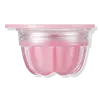What's inside
What's inside
 Key Ingredients
Key Ingredients

No key ingredients
 Benefits
Benefits

 Concerns
Concerns

 Ingredients Side-by-side
Ingredients Side-by-side

Camphor 1%
MaskingMenthol 1%
MaskingPetrolatum 59.14%
EmollientPhenol 0.54%
AntimicrobialBeeswax
Emulsion StabilisingBenzyl Alcohol
PerfumingDiisopropyl Adipate
EmollientAroma
Parfum
MaskingLanolin
EmollientMenthoxypropanediol
MaskingMicrocrystalline Wax
Emulsion StabilisingMyristyl Myristate
EmollientRicinus Communis Seed Oil
MaskingSaccharin
MaskingTheobroma Cacao Seed Butter
EmollientDiisostearyl Malate
EmollientPolybutene
Hydrogenated Polyisobutene
EmollientTrimethylolpropane Triisostearate
EmollientPentaerythrityl Tetraisostearate
EmollientSilica Dimethyl Silylate
EmollientHydroxystearic Acid
CleansingPhenyl Trimethicone
Skin ConditioningEthylene/Propylene/Styrene Copolymer
Parfum
MaskingTocopheryl Acetate
AntioxidantBenzyl Benzoate
AntimicrobialDehydroacetic Acid
PreservativeLinalool
PerfumingButylene/Ethylene/Styrene Copolymer
Limonene
PerfumingHexyl Cinnamal
PerfumingPentaerythrityl Tetra-Di-T-Butyl Hydroxyhydrocinnamate
AntioxidantLitchi Chinensis Fruit Extract
Skin ConditioningWater
Skin ConditioningButylene Glycol
Humectant1,2-Hexanediol
Skin ConditioningDiisostearyl Malate, Polybutene, Hydrogenated Polyisobutene, Trimethylolpropane Triisostearate, Pentaerythrityl Tetraisostearate, Silica Dimethyl Silylate, Hydroxystearic Acid, Phenyl Trimethicone, Ethylene/Propylene/Styrene Copolymer, Parfum, Tocopheryl Acetate, Benzyl Benzoate, Dehydroacetic Acid, Linalool, Butylene/Ethylene/Styrene Copolymer, Limonene, Hexyl Cinnamal, Pentaerythrityl Tetra-Di-T-Butyl Hydroxyhydrocinnamate, Litchi Chinensis Fruit Extract, Water, Butylene Glycol, 1,2-Hexanediol
 Reviews
Reviews

Ingredients Explained
These ingredients are found in both products.
Ingredients higher up in an ingredient list are typically present in a larger amount.
Parfum is a catch-all term for an ingredient or more that is used to give a scent to products.
Also called "fragrance", this ingredient can be a blend of hundreds of chemicals or plant oils. This means every product with "fragrance" or "parfum" in the ingredients list is a different mixture.
For instance, Habanolide is a proprietary trade name for a specific aroma chemical. When used as a fragrance ingredient in cosmetics, most aroma chemicals fall under the broad labeling category of “FRAGRANCE” or “PARFUM” according to EU and US regulations.
The term 'parfum' or 'fragrance' is not regulated in many countries. In many cases, it is up to the brand to define this term.
For instance, many brands choose to label themselves as "fragrance-free" because they are not using synthetic fragrances. However, their products may still contain ingredients such as essential oils that are considered a fragrance by INCI standards.
One example is Calendula flower extract. Calendula is an essential oil that still imparts a scent or 'fragrance'.
Depending on the blend, the ingredients in the mixture can cause allergies and sensitivities on the skin. Some ingredients that are known EU allergens include linalool and citronellol.
Parfum can also be used to mask or cover an unpleasant scent.
The bottom line is: not all fragrances/parfum/ingredients are created equally. If you are worried about fragrances, we recommend taking a closer look at an ingredient. And of course, we always recommend speaking with a professional.
Learn more about Parfum